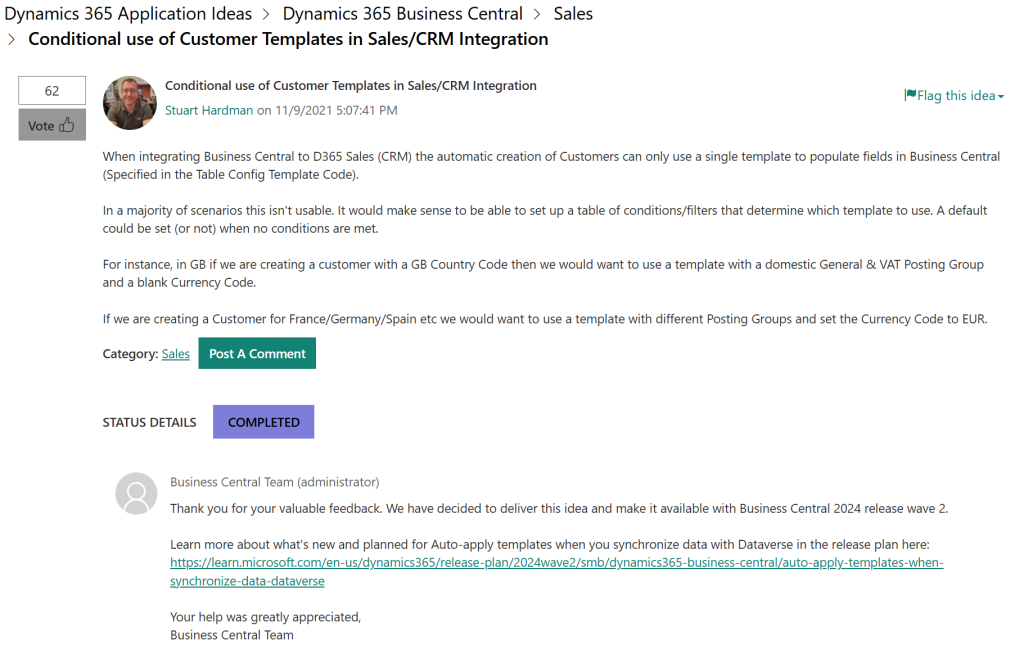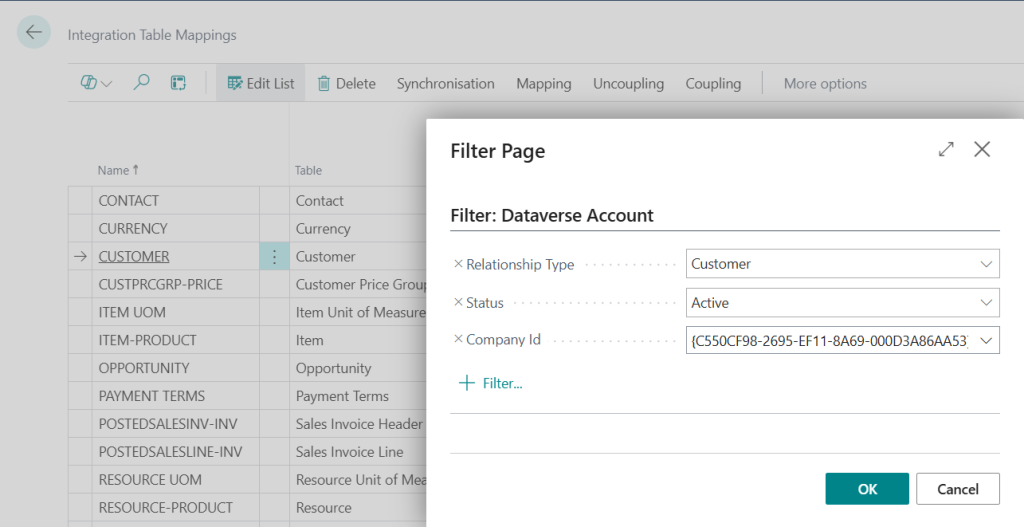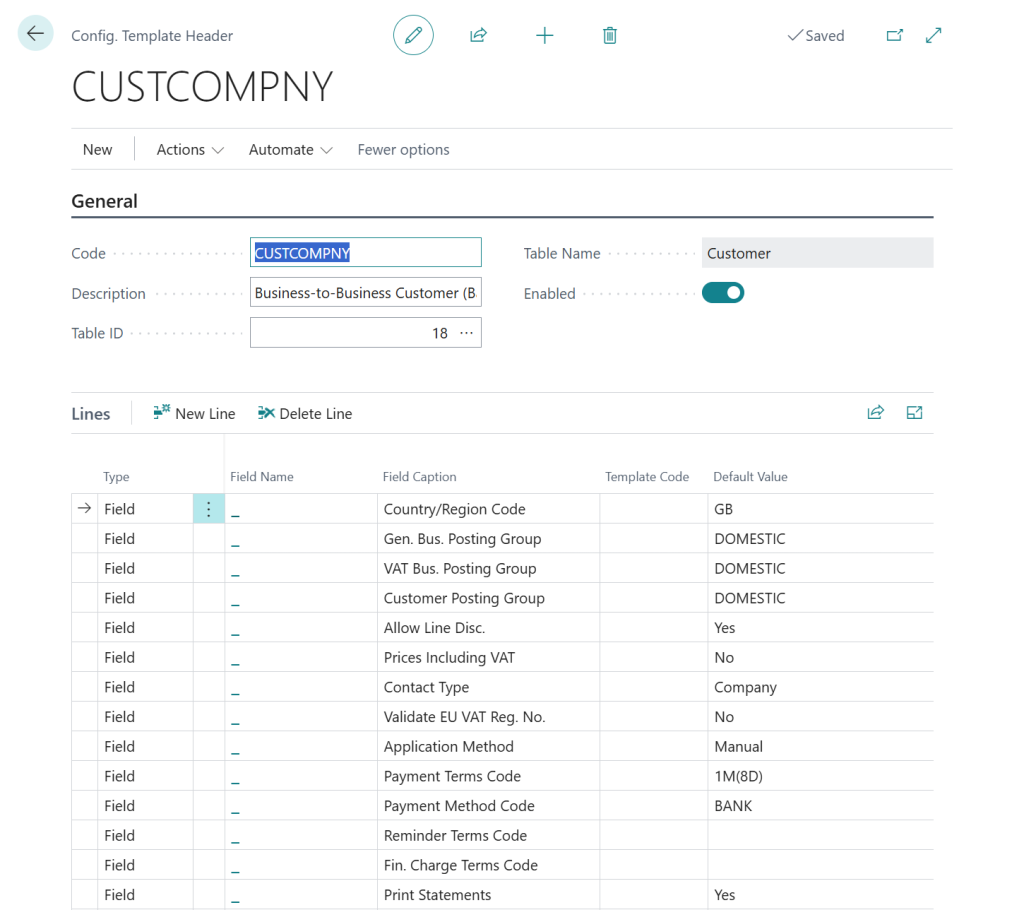What’s New and Business Central Ideas
With cloud based finance and ERP systems it’s always important to stay on top of what’s new in the product. Each April and October, Microsoft release updates to their Dynamics products in the form of ‘Release Waves’. The functionality is mostly driven by Microsoft and their overall direction for the products. But, a lesser known influence is the Dynamics 365 Application Idea page. Whether you are a Business Central expert or a customer, you can create and vote for ideas on this page. Microsoft closely monitor these pages and where they feel ideas can add value and improve the products they will put them on their roadmap.
When reading through the Business Central 2024 Release Wave 2 What’s New and Planned page the very first item seemed familiar – Auto-apply templates when you synchronize data with Dataverse. Sure enough, when looking through the ideas that I have posted, one of them has been accepted by Microsoft and implemented in the product! This is the fourth idea that i’ve had implemented and there is another one currently planned for release (watch this space) which goes to show Microsoft really do listen to feedback provided.

Sales Integration (or CRM Integration?)
So what does this amendment actually mean? Firstly, let’s start with some terminology. Dynamics 365 Sales was formerly known as Microsoft Dynamics CRM so when I talk about the Sales Integration it can be interchanged with CRM Integration. This solution sits on top of the Microsoft Dataverse platform and Business Central synchronises at that level.
Within Business Central you set up the sales integration to allow the data to synchronise between the two systems. This means that your sales team can work in Dynamics 365 Sales whilst your operations and finance teams can work in Business Central and both of them will see consistent data. When a record is created or modified in one, that change will flow through to the other to ensure one version of the truth.
However, the data requirements between the two systems differ. In sales the users are more concerned about contacts, interactions and opportunity management. In Business Central it is more structured and relies on clearly defined setup to make sure that transactions post in the correct places. For this reason templates are used to ensure the correct information is populated into key fields.
The simplest example of this is when creating an Account in Dynamics 365 Sales. At some point that quote you’ve sent them could become an order and you want them to become a customer.

When the Account has a Relationship Type of “Customer” it is the trigger for Business Central to synchronise and create them as a Customer.

When Business Central creates a Customer it needs a lot more information than just a name and address, for instance it needs to know:
- Where to post transactions
- What VAT to calculate
- What Currency Code to use
- Payment Terms
And a whole lot more! This is where Customer Templates come into play, you can create a template that contains all of the information that Business Central needs to deal with transactions.

Historically the CRM integration functionality only allowed you to use one default template when synchronising Customers to Business Central from Dynamics 365 Sales. It didn’t matter if the customer was in the EU, the USA or China, they’d get the same setup. You’d then have to manually change it or write some code to handle different scenarios.
“That’s crazy!” I thought. Surely you could just make some changes to the setup to allow different scenarios to use different templates. That’s why I created my idea suggesting this.
The new functionality allows you to use filters to determine which templates to use. For instance, if the Country/Region in Dynamics 365 Sales is US (or variations of it) you can tell the system to use a US Customer Template.

Multiple different filters can be setup and given priorities to determine in which order they should be dealt with, this allows you to have a catchall for when none of the filters apply.

This can all be set up from the Integration Table Mapping page (accessed from the Dynamics 365 Sales Integration Setup page in Business Central). You can also easily see where you have multiple templates setup for different synchronisations.

Don’t forget that you don’t have to be a Business Central expert to register an idea or to vote for existing ideas. You too can make a difference!
Talk to a Business Central Expert
If you’re looking for some help with the CRM integration with Business Central or want to know more about what’s new then you’ll want to talk to a Business Central expert. Feel free to give us a call or drop us a note from our Contact Us page to discuss any of this further.
